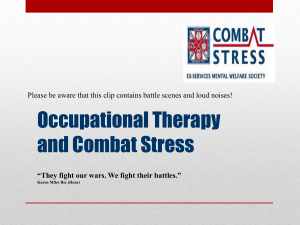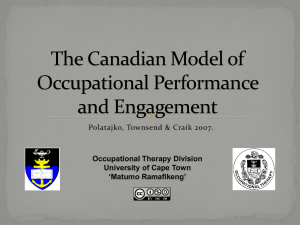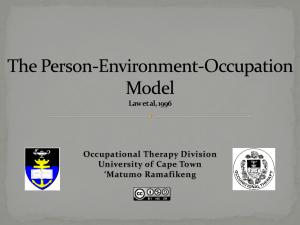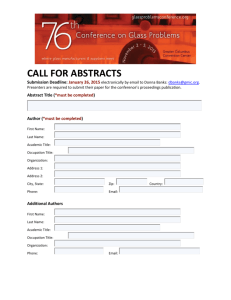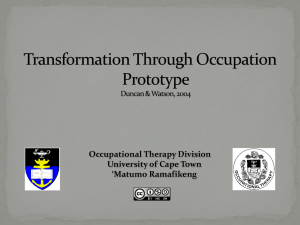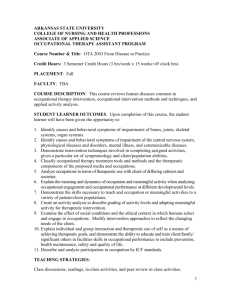The Canadian Model of Occupational Performance and
advertisement
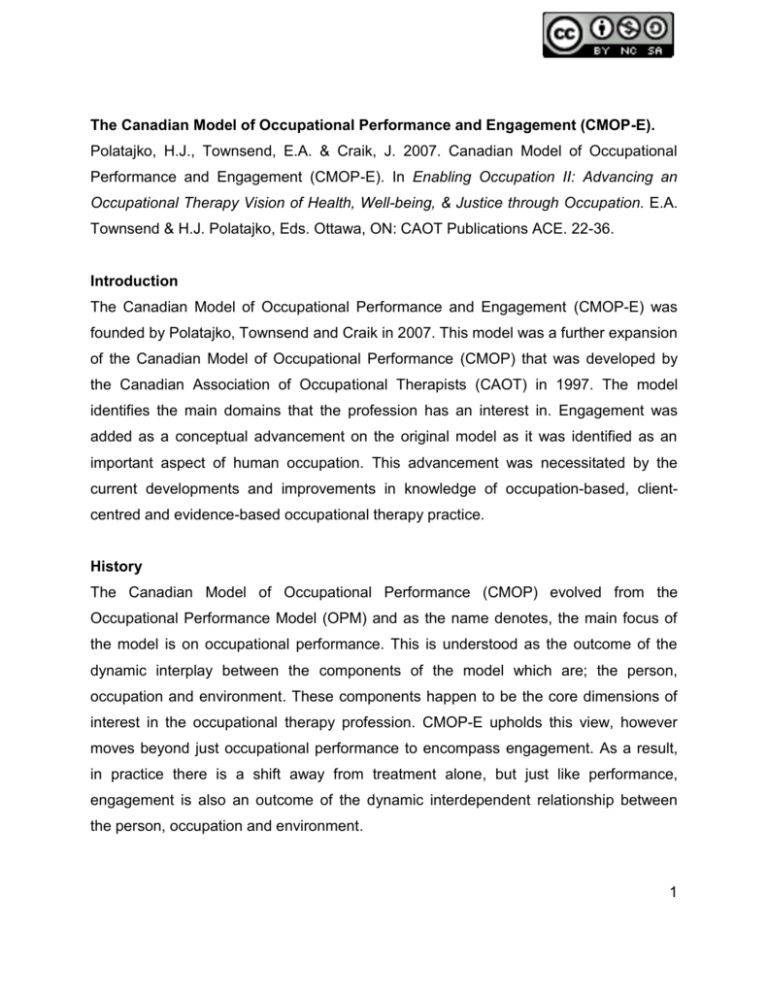
The Canadian Model of Occupational Performance and Engagement (CMOP-E). Polatajko, H.J., Townsend, E.A. & Craik, J. 2007. Canadian Model of Occupational Performance and Engagement (CMOP-E). In Enabling Occupation II: Advancing an Occupational Therapy Vision of Health, Well-being, & Justice through Occupation. E.A. Townsend & H.J. Polatajko, Eds. Ottawa, ON: CAOT Publications ACE. 22-36. Introduction The Canadian Model of Occupational Performance and Engagement (CMOP-E) was founded by Polatajko, Townsend and Craik in 2007. This model was a further expansion of the Canadian Model of Occupational Performance (CMOP) that was developed by the Canadian Association of Occupational Therapists (CAOT) in 1997. The model identifies the main domains that the profession has an interest in. Engagement was added as a conceptual advancement on the original model as it was identified as an important aspect of human occupation. This advancement was necessitated by the current developments and improvements in knowledge of occupation-based, clientcentred and evidence-based occupational therapy practice. History The Canadian Model of Occupational Performance (CMOP) evolved from the Occupational Performance Model (OPM) and as the name denotes, the main focus of the model is on occupational performance. This is understood as the outcome of the dynamic interplay between the components of the model which are; the person, occupation and environment. These components happen to be the core dimensions of interest in the occupational therapy profession. CMOP-E upholds this view, however moves beyond just occupational performance to encompass engagement. As a result, in practice there is a shift away from treatment alone, but just like performance, engagement is also an outcome of the dynamic interdependent relationship between the person, occupation and environment. 1 Theoretical Underpinning Some of the theories that inform the model include humanistic theories, evident in the emphasis on client centredness, as well as accompanying principles. Developmental and learning theories are also portrayed in the belief that the person has the ability to adapt and acquire skills. The environmental theories also played a role and are acknowledged in how the model considers environment as an important component and influence on human occupation. Being developed from different theoretical backgrounds creates an interdisciplinary foundation for the model. Assumptions The model is based on the assumptions and core beliefs of the profession. It is also informed by the principles of client centredness. Another assumption that informs the model is that occupations are contextually and developmentally determined and influenced. The model CMOP-E aims to promote client-centred practice and the profession’s view that occupation is the core domain of concern. Application of the model enables optimal function of the occupational therapist within a multidisciplinary team and therefore strengthens the role of occupational therapy. With the introduction of engagement, the model extends interest to not only performing occupations, but having them as well. This broadens the scope of practice of the profession. The model envisions health, wellbeing and justice as attainable through occupation and promotes this vision. Components The CMOP-E is made up of three components, namely; the person, the environment and the occupation. 2 Pictorial representation of CMOP-E Figure 1. The CMOP-E1: Specifying our domain of concern (Used with permission from CAOT Publications ACE) A.1 Referred to as CMOP in Enabling Occupation in previous editions (1997 and 2002) and CMOP-E as of the 2007 edition (Polatajko et al., 2007) B. Trans-sectional view Person The person is situated at the centre of the model and is represented by a triangle. The three performance components that make up the person are located in each of the corners of the triangle and these are: cognitive, affective and physical. CMOP is the first framework to acknowledge and find a place for spirituality in human occupation and this is positioned at the core of the person. This spirituality is shaped and expressed through occupations. Spirituality does not refer to religion, but the essence of self, the place where determination and meaning are drawn. However, some individuals may explore 3 spirituality through religion. The depiction of the model shows the person as existing within the environment (represented by the outer circle). Environment The outer circle of the model depicts the environment within which individuals exist and where occupations occur. The environment influences the person and the occupation in different ways and these are classified into four components, namely: physical, cultural, institutional and social. It is within this dimension that individuals are presented with occupational opportunities. Occupation In this model occupation is classified into three categories referred to as occupational purposes and these are; self-care, productivity and leisure. The inner circle represents occupation and in the transverse sectional view, it comes at the forefront, indicating that occupation is the core domain of concern to occupational therapists. It is through occupation that the person interacts with the environment; therefore occupation becomes the link between the person and the context, as well as a means through which the environment is acted upon. Function-dysfunction continuum A change in one component results in a change all the other dimensions due to the interdependent relationship between them, therefore a disruption in one component can result in occupational dysfunction. When there are limitations in any of the components of the model, the outcome of this interdependent relationship becomes dysfunctional occupational performance or engagement. Function is denoted by a harmonious interdependent relationship between the person, occupation and environment. Implications for practice The nature of the model allows for use among all age groups and with different diagnoses. It is also flexible enough to permit use with other assessment tools, although 4 the Canadian Occupational Performance Measure (COPM) was developed as a tool for use with the model. In addition to that, the successful use of the predecessor (CMOP) has shown that the model can be used in multicultural settings. The comparability and congruence of the model to the International Classification of Functioning Disability and Health (ICF) (WHO, 2001) positions the framework at an international standard and highlighting a possibility of developing an occupation focused model into a health model based on occupation. This could further indicate the role that occupation plays in health and well-being. The model further broadens the scope of practice on creating environments that are occupationally supportive. References: Clarke, C. 2003. Clinical application of the Canadian Model of Occupational Performance in a forensic rehabilitation hostel. British Journal of Occupational Therapy. 66(4)171-174. Grant, D.D. & Lundon, K. 1998. The Canadian Model of Occupational Performance applied to females with osteoporosis. Canadian Journal of Occupational Therapy. 66(4)3-12. Polatajko, H.J., Townsend, E.A. & Craik, J. 2007. Canadian Model of Occupational Performance and Engagement (CMOP-E). In Enabling Occupation II: Advancing an Occupational Therapy Vision of Health, Well-being, & Justice through Occupation. E.A. Townsend & H.J. Polatajko, Eds. Ottawa, ON: CAOT Publications ACE. 22-36. World Health Organization. 2001. International Classification of Functioning, Disability and Health. Geneva: WHO. Conceptual Frameworks by Matumo Ramafikeng, Health Sciences UCT, 2010 Licensed under a Creative Commons Attribution-Noncommercial-Share Alike 2.5 South Africa License. 5
